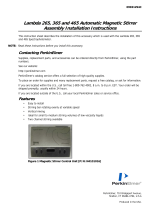
4
Remove the instrument and accessories from the packaging and verify
damage has not occurred during shipping. Remove protective film from
stirrer. Please contact your local Hanna Instruments Office.
Each stirrer is supplied with a magnetic stir bar.
Note: Save all packing material until you are sure that the instrument
works correctly. Any defective item must be returned in its original
packing.
The Hanna Instruments series of magnetic stirrers are designed with sim‑
plicity of use for stirring and mixing solutions in a wide range of laboratory
applications. Several models are available in an extensive range covering:
• general purpose stirrers
• dual‑speed range
• auto‑reverse cycle stirring
• rpm indication
• timer control
All models employ a motorized magnet to rotate a stirring bar to create a
forced vortex rotational flow in the solution with a constant angular speed
which is adjustable with an external speed knob.
Unlike conventional stirrers, all Hanna Instruments stirrers use the concept
of pulse‑driven drive to give the full power required to effectively stir the
fluid regardless of the speed. This eliminates the need to start the motor at
high speed and the user is now able to control the speed precisely.
Each stirrer is equipped with an opto‑sensor for speed monitoring, and a
speed limiter circuit that prevents hazardous operation when the load is
suddenly removed.
The power required to effectively stir a fluid is affected by the torque load
on the stirrer which is dependent on the capacity, type and viscosity of the
fluid. The speed of the stirrer decreases as the torque load increases and vice
versa, unless the power delivered changes accordingly.
For Newtonian fluids like water, the viscosity remains constant during stir‑
ring. General purpose, normal stirrers are ideal for this kind of fluids. For
some fluids like oil and clay, the viscosity changes during the stirring pro‑
cess, making it necessary to adjust the power to maintain a constant speed
during the stirring.
PRELIMINARY EXAMINATIONGENERAL DESCRIPTION























